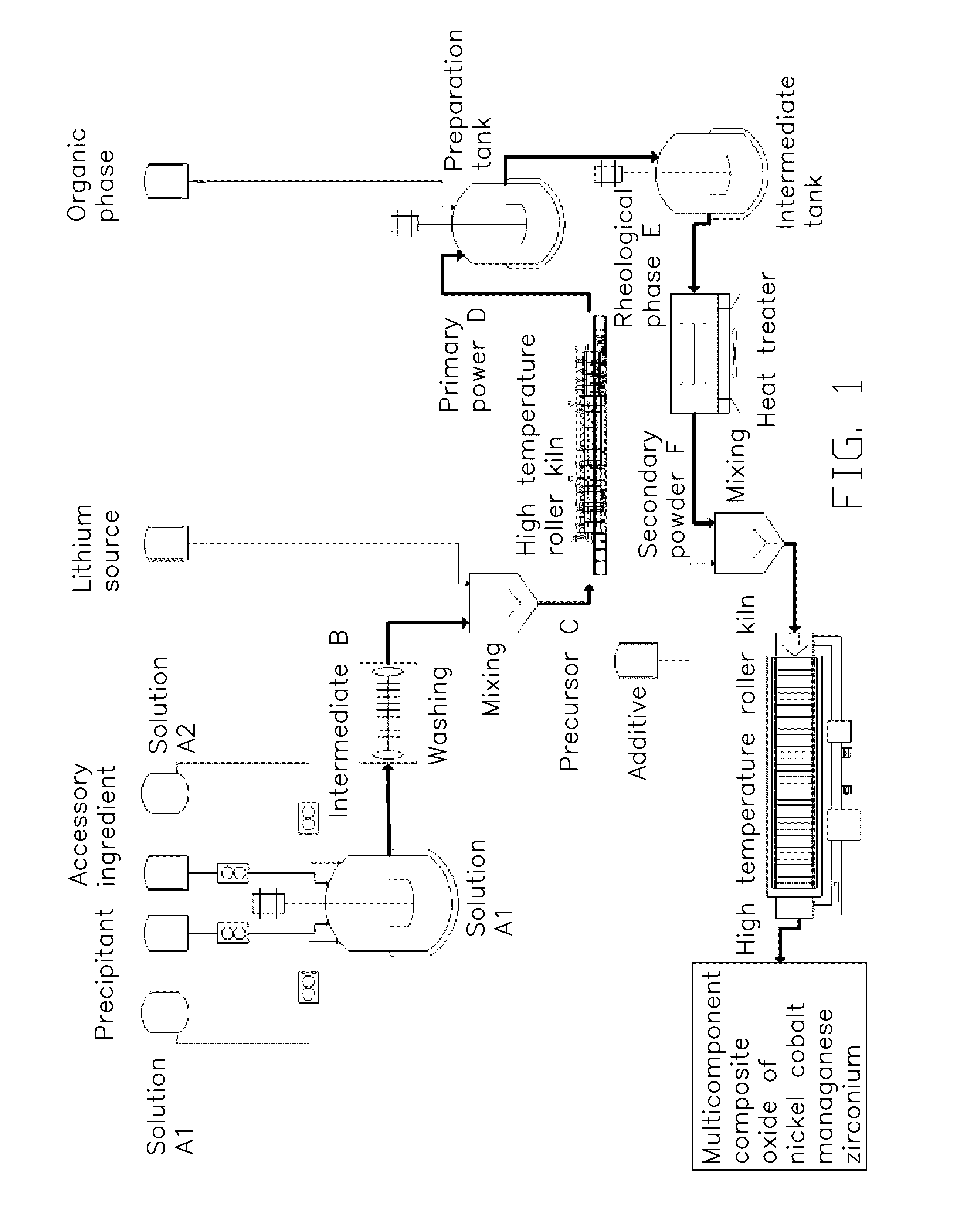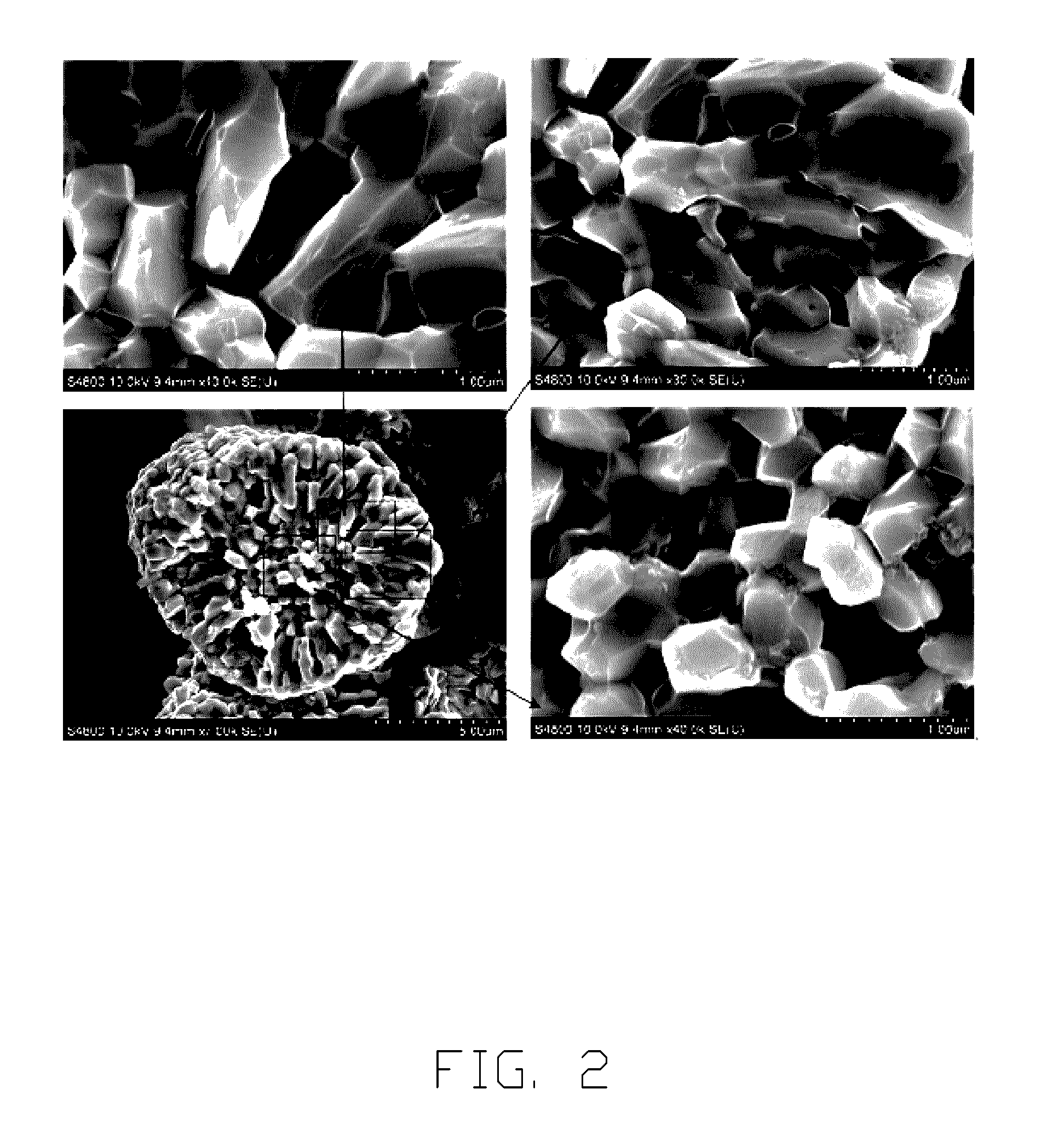Polynary composite oxide, preparation method and use thereof
a composite oxide and polynary technology, applied in the field of polynary composite oxide manufacturing method and polynary composite oxide, can solve the problems of limiting the material which is not conductive to improve the rate performance of the material, shortening the grinding time, and reducing the production cost. , the effect of low energy consumption
- Summary
- Abstract
- Description
- Claims
- Application Information
AI Technical Summary
Benefits of technology
Problems solved by technology
Method used
Image
Examples
example 1
[0050]The nickel sulfate and the cobalt sulfate were mixed at a molar ratio of Ni:Co=0.331:0.379 to prepare 1 mol / L of a first solution. The manganese sulfate and the zirconium sulfate were mixed at a molar ratio of Mn:Zr=0.237:0.029 to prepare 1 mol / L of a second solution, and the first and second solutions were mixed and stirred at a rotating rate of 200 r / min. 5 mol / L of the sodium hydroxide solution and 5 mol / L of the ammonia were added into the mixed solution, and then the mixed solution adjusted to a pH value of 11.5 to gradually subside intermediate. The intermediate was washed and mixed with the lithium carbonate, where molar ratio of the lithium element is less than 10%, and then placed into the high temperature roller kiln to be decomposed and oxidated, to obtain the primary powder. Then primary powder was placed into the preparation tank, and ethylene glycol was pumped in the preparation tank, and then the primary powder and the ethylene glycol were stirred at the rotatin...
example 2
[0053]The nickel sulfate and the cobalt sulfate were mixed at a molar ratio of Ni:Co=0.317:0.363 to prepare 0.1 mol / L of a first solution. The manganese sulfate and the zirconium sulfate were mixed at a molar ratio of Mn:Zr=0.227:0.048 to prepare 0.1 mol / L of a second solution, and these solutions were mixed and stirred at a rotating rate of 200 r / min. 0.2 mol / L of the potassium hydroxide solution and 0.5 mol / L of the ammonia were added into the mixed solution, and then the mixed solution adjusted to a pH value of 11.0 to gradually subside intermediate. The intermediate was washed and mixed with the lithium carbonate, the molar ratio of lithium element being less than 20%, and then placed into the high temperature roller kiln to be decomposed and oxidated, to obtain the primary powder. Then primary powder was placed into the preparation tank, and hexylene glycol pumped in the preparation tank, and then the primary powder and the hexylene glycol were stirred at the rotating rate of 1...
example 3
[0054]The nickel sulfate and the cobalt sulfate were mixed at a molar ratio of Ni:Co=0.333:0.381 to prepare 3 mol / L of a first solution. The manganese sulfate and the zirconium sulfate were mixed at a molar ratio of Mn:Zr=0.238:0.001 to prepare 3 mol / L of a second solution, and these solutions mixed and stirred at a rotating rate of 100 r / min. 6 mol / L of the sodium carbonate solution and 6 mol / L of the ammonia were added into the mixed solution, and the mixed solution adjusted to a pH value of 11.0 to gradually subside intermediate. The intermediate was washed and mixed with the lithium carbonate, where the molar ratio of lithium element is less than 20%, and then placed into the high temperature roller kiln to be decomposed and oxidated to obtain the primary powder. Then primary powder was placed into the preparation tank, and ethyl alcohol was pumped in the preparation tank, and then the primary powder and the ethyl alcohol were stirred at the rotating rate of 100 r / min. The slurr...
PUM
 Login to View More
Login to View More Abstract
Description
Claims
Application Information
 Login to View More
Login to View More - R&D
- Intellectual Property
- Life Sciences
- Materials
- Tech Scout
- Unparalleled Data Quality
- Higher Quality Content
- 60% Fewer Hallucinations
Browse by: Latest US Patents, China's latest patents, Technical Efficacy Thesaurus, Application Domain, Technology Topic, Popular Technical Reports.
© 2025 PatSnap. All rights reserved.Legal|Privacy policy|Modern Slavery Act Transparency Statement|Sitemap|About US| Contact US: help@patsnap.com



